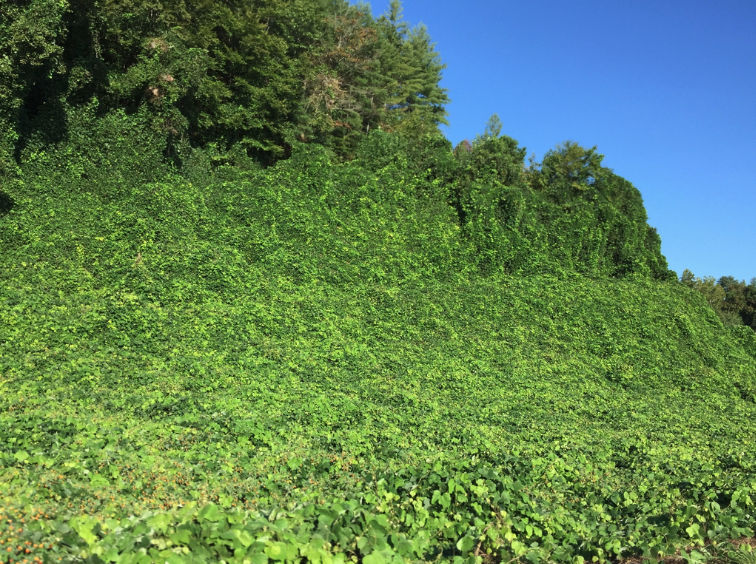What Can You Do About Kudzu?
go.ncsu.edu/readext?870716
en Español / em Português
El inglés es el idioma de control de esta página. En la medida en que haya algún conflicto entre la traducción al inglés y la traducción, el inglés prevalece.
Al hacer clic en el enlace de traducción se activa un servicio de traducción gratuito para convertir la página al español. Al igual que con cualquier traducción por Internet, la conversión no es sensible al contexto y puede que no traduzca el texto en su significado original. NC State Extension no garantiza la exactitud del texto traducido. Por favor, tenga en cuenta que algunas aplicaciones y/o servicios pueden no funcionar como se espera cuando se traducen.
Português
Inglês é o idioma de controle desta página. Na medida que haja algum conflito entre o texto original em Inglês e a tradução, o Inglês prevalece.
Ao clicar no link de tradução, um serviço gratuito de tradução será ativado para converter a página para o Português. Como em qualquer tradução pela internet, a conversão não é sensivel ao contexto e pode não ocorrer a tradução para o significado orginal. O serviço de Extensão da Carolina do Norte (NC State Extension) não garante a exatidão do texto traduzido. Por favor, observe que algumas funções ou serviços podem não funcionar como esperado após a tradução.
English
English is the controlling language of this page. To the extent there is any conflict between the English text and the translation, English controls.
Clicking on the translation link activates a free translation service to convert the page to Spanish. As with any Internet translation, the conversion is not context-sensitive and may not translate the text to its original meaning. NC State Extension does not guarantee the accuracy of the translated text. Please note that some applications and/or services may not function as expected when translated.
Collapse ▲The hills are alive with the sound of….kudzu growing. Sorry, this is no Rogers and Hammerstein musical, and I am certainly no Julie Andrews. But the hills are surely, greenly alive with such a fast-growing vine you can almost hear it growing.
Kudzu (Pueraria montana var. lobata) is a fast-growing vine native to Asia that was introduced into the US in the late 1800s as an ornamental plant and for erosion control. While it is both of those things (the purple flower clusters are highly aromatic when peeking out from under the large leaves in late summer), its impact is decimating native species by growing about a foot per day under the right conditions. It smothers other plants under a solid blanket of leaves, blocking them from needed sunlight. The vines twine around trees and shrubs in a strangle-hold breaking branches and bringing them to the ground under the mass of vines. In the past cold winters would keep Kudzu in check but as the weather stays warmer, kudzu can stay on the move taking over everything in its path. The dead vines from previous seasons function as a trellis for this plant to climb up, over and keep on moving.
What to do if it has started moving in on you? Don’t stand still. If it’s small enough, remove it quickly as it won’t stay small very long. It spreads primarily through runners, rhizomes, and vines that root at the nodes of the plant. There can be as many as thirty vines growing (and rooting in again) from a single root crown.
Believe it or not kudzu is not invincible. There are different things that can be done at different stages from herbicides, to biocontrols, to mechanical intervention. That is the concept of IPM – Integrated Pest Management with Multiple Approaches. Whenever your approach includes chemical control, read and follow the labeling on the product you are using for your safety and success. Foliar chemical applications depend on getting really good coverage of the foliage (leaves). Wet to the point of dripping without wasting the product. Spray at head height, not above and spray while you carefully back through the plant mass so the chemistry stays on the plant and not on you. Understand that this is not a “once and you’re done”. These are big leaves, that shelter leaves underneath from getting good contact with the herbicide. Recall the growth rate and trellis habit mentioned earlier. It will be back. Some of the older vines will have grown into woody trunks. If this is the case on your site you can use the “cut stump” technique, sawing through the vine and painting/squirting herbicide coating the cut area so it soaks in and kills the plant at the tuber.
Biocontrol is another approach, but it’s limited. Kudzu bugs do eat kudzu. And other legumes like soybeans, other bean species and wisteria. These little stink bugs will reduce the plant mass but not eliminate it. They can be a nuisance problem in and of themselves. Grazers are another biocontrol method. Kudzu was once used as a forage to try to feed cattle and sheep with. Its forage quality is similar to alfalfa with a protein content of about 15 to 18%. Lately another option used with success has been goats. Seriously, grazing goats are effective at eating the vine down especially in areas you can’t access with a sprayer or the lawn mower. After a few years of being eaten to the ground the kudzu can’t recover and dies.
Lastly, there is mechanical intervention. Excavate the tuber with taproot if your area is small. It will take some strong back muscle and a sturdy shovel to get it all. If the kudzu has gotten a thorough start and you can access it safely, then mow it down to knock it back so it doesn’t spread as rapidly. To find out more information about IPM resources contact your local Extension office.





